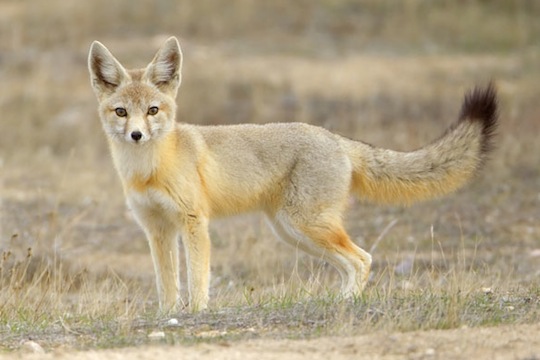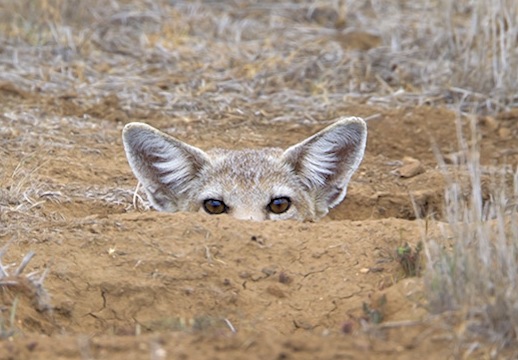Vulpes Macrotis Mutica
By: Ricardo Hesse
 |
| Source: http://faculty.ucr.edu/~chappell/INW/mammals/kitfox.shtml |
Descriptions and
Ecology of Organism
The Vulpes Macrotis Mutica, also known as the San Joaquin Kit Fox, is a
subspecies of the Vulpes Macrotis,
the Kit Fox. In the past there were eight sub species of it Fox that were
recognized to exist, but as of 1993 there are only two that are recognized, the
San Joaquin Kit Fox and all the rest fall under the category of Kit Fox.
 |
| Source: http://www.treehugger.com/endangered-species/little-kit-foxes-go-romp.html |
The San Joaquin Kit Fox is the smallest canid species in North America; males are on average 31.7 inches long and females 30.3 inches long. The average height at the shoulder for them is 12
inches and they weigh from 4.6-5 pounds. Their fur tends to vary depending on
the zone as well as the season of the year, the most common color for the fur
is a yellowish gray colored. In the winter it leans more towards a gray coat
and in the summer it develops a more tan color. They are able to be identified
by their distinctly black-tipped tail and their long ears.
The SJ Kit Fox tends to be a
nocturnal animal and lives mostly in underground dens to keep away from hot or
cold climates, these shelters also serve as protection against predators. They
tend to eat whatever they can get their hands on, but specifically tend to eat
insects, rodents, and rabbits. The SJ Kit Fox is k-selected and tend to pair
during October and November and mate for life, as they are primarily monogamous
animals, and breed in December and January. The pregnancy period is 49-55 days
and the typical litter size is about 4, but ranges from 1-9. Fox parents will
care for their young for about 4-5 months as then it is typically seen that
they are able to find food for themselves.
Geographic and
population changes
The San Joaquin Kit Fox was once a
very populated species that resided in the native grasslands of the San Joaquin
Valley California. They are located in arid and semi-arid regions including
desert scrub, chaparral, halophytic, and grassland areas. In current times the
kit fox is now found only on the edges of the valley ranging from Southern Kern
Country all the way up to Alameda, Contra Costa, and San Joaquin counties on
the west and east in the Stanislaus County; in the Valley floor there are now
very few populations compared to before where that was the main location. Based
on recent recovery plan studies there is believed to be below 7000 SJ Kit Foxes
left, which is a population decline of 20-43% of what was estimated through
studies back in the 1930s.
 |
| Source: http://esrp.csustan.edu/gis/ |
Listing Date and Type
of Listing
The SJ Kit Fox has had to recovery
plans created for the species. It was listed back in 1967 as an endangered species
by the U.S. Fish and Wildlife Services, and then in 1971 listed as threatened
by the California department of Fish and Wildlife. The First recovery plan was
created by Suzanne N. Nelson and lasted from 1992 to 1996, the current Recovery
Plan was created in 1998. The San Joaquin Kit Fox continues to be listed as an
endangered sub species of the Kit Fox.
Cause of Listing and
Main threats
There are several reasons for the decline
in kit fox population and why it has been listed. Things such as predation,
starvation, flooding, disease and drought increased the natural mortality rate.
Due to human interactions through shooting, trapping, poisoning, road kill they
SJ Kit Fox population has decreased as well. The biggest factor behind the loss
in population is due to habitat loss and degradation as their habitat was
turned into agricultural, industrial, and urban developments. The San Joaquin Kit fox is hunted by coyotes
and red foxes as well as competing for food with them. Rat poison is also
killing them because of the poison that is accumulated in their prey.
 |
| Source: https://www.thinglink.com/scene/569581576648654848 |
Description of
Recovery Plan
The San
Joaquin Kit Fox is an umbrella species, and as such, the recovery of this species
is critical for other species that reside in the San Joaquin Valley as well.
The goal is to create and conserve a number of populations throughout its
geographic range because of their need of such a large area, but still have
ways for the populations to connect with one another to promote genetic
diversity. The three core populations that would be protected would be the
Carrizo Plain Natural Area, Natural Lands of Western Kern County, and the
Ciervo-Panoche Natural Area of western Fresno. Another action being done is to
reduce how isolated kit foxes are by promoting “safe harbor” on agricultural lands
as well as the reduction of agricultural lands that have too much damage to be sustainable
as farm land. There is also more information and studies needed on the SJ Kit
Fox which is another thing this recovery plan hopes to do. Information on
distribution, accurate and new population studies, as well as interactions with
other species will be researched and gained throughout this recovery process.
Ways to help?
There
are many groups that are promoting knowledge on the San Joaquin kit Fox as well
as promoting ways in which one can help the species. One of the main groups
leading this is, of course, the California Department of US Fish and Wildlife (https://www.wildlife.ca.gov/) and
Defenders of Wildlife (http://www.defenders.org/).
Some things one can do are:
·
Sealing trash containers
·
Put away bird feeders at night
·
Pick up fallen fruit and cover trash piles
·
Don’t use traps in areas where Kit Foxes are
located
·
Never fill or destroy a burrow (they are
protected by State and federal laws)
·
Take down and furl up sports nets to prevent
tangling
·
Avoid using rat poison in kit fox habitats
 |
| Source: http://faculty.ucr.edu/~chappell/INW/mammals/kitfox.shtml |
Works Cited
- "Basic Facts on San Joaquin Kit Foxes" Defenders of Wildlife. Defenders of Wildlife, n.d. Web.
- California Department of U.S. Fish and Wildlife. "keep me Wild: Kit Fox." CA.Gov. State of California, n.d. Web.
- U.S. Fish and Wildlife Service. 1998. Recovery plan for upland species of the San Joaquin Valley, California. Region 1, Portland, OR. 319 pp.
- Cyphers, B. & List, R.2014. Vulpes macrotis. The IUCN Red List of Threatened Species 2014: e.T41587A62259374.
This comment has been removed by the author.
ReplyDeleteThese foxes are so cute - but there are reasons more than that to conserve them! As an umbrella species, the conservation of these cute little guys will ensure the conservation of other species in the San Joaquin Valley. I didn't even know this species existed, thanks for bringing it to my attention Ricardo! #bio227fall2015
ReplyDeleteThis blog is amazing. I had no idea bird feeders or fallen fruit could harm this species. I am so happy you've informed us of ways we can help this species! They are so adorable. #bio227fall2015
ReplyDeleteWe have to limit human interaction with these foxes! Hunting them and destroying their habitat will ensure the extinction of many other species, being that the San Jaoqin Kit Fox is an umbrella species. #BIO227Fall2015
ReplyDeleteI was really intrigued when I learned that fallen fruit could harm this species, I didn't know that was possible. Now I know some simple ways to help save this cute little species! #BIO227Fall2015
ReplyDeleteWow what an adorable species! I didn't know how important the San Joaquin Kit Fox was to the other species around it. I now realize how necessary it is to conserve them! #BIO227Fall2015
ReplyDeleteWhat an interesting blog about kit foxes. It was very informative, and I am now more enlightened.
ReplyDelete